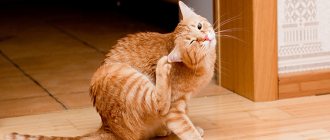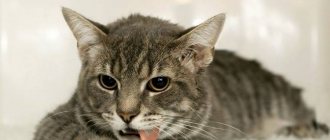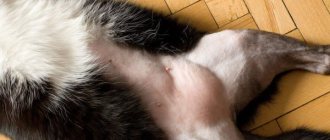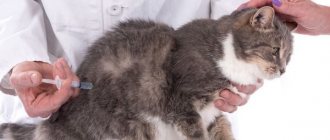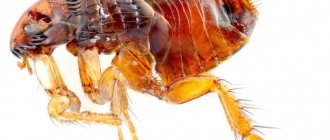Many pet cat owners are familiar with the problem of fleas appearing in their pet's fur. These blood-sucking insects not only cause serious discomfort to the animal, but can also carry dangerous diseases. The more fleas there are, the higher the risk of an allergic reaction, dermatitis or infection. Therefore, you need to learn how to detect these parasites in time and know how to get rid of them.
Fleas are common blood-sucking insects that live in animal fur. These parasites have a flattened body, thanks to which they easily move in the fur. Capable of jumping high - up to 30 cm. They bite through the skin and feed on the pet's blood, usually living on the stomach, near the ears - in those places where the skin is thinner.
What do fleas look like?
Fleas belong to a large order of insects, which include different subspecies. They feed on the blood of various animals and are parasites. Using a photo of fleas on a cat, you can determine the type of flea and understand that the animal is attacked by these insects.
The cat flea is one of the most common species; its body length reaches up to three millimeters. The flea has a body that is flattened on the sides, and their hind legs are very long.
- It is thanks to their long legs that they are so easily carried along the fur; female fleas are larger than males, since they lay eggs and carry them in their abdomen.
- The flea has a sucking and piercing mouth, with which it pierces the cat's skin and drinks its blood.
- There are many bristles on the surface of the flea's body, which also allows the parasite to cling tightly to the fur.
- The color of the flea can be light brown and reach black.
Lifestyle and nutrition of future parasites
Flea larvae are not parasites, since they feed on decaying organic compounds, which make up particles of dead plants, excrement of formed fleas, containing undigested crusts of the victim's blood.
The larvae themselves do not feed on blood, therefore in this state they are harmless to humans and animals.
Maturation of the larvae lasts from 2 to 14 days. After this, the eggs hatch and small parasites continue to develop. The period of final maturation depends on environmental conditions; the more comfortable the larva feels, the faster the process of formation of the individual occurs.
If the ambient temperature is warm enough and there is a high level of humidity, the larvae will develop into an adult within a couple of days. An underdeveloped individual feeds on the feces of mature individuals, dried blood crust, and other layers of organic matter.
As the larva grows, it molts (3 times), after which it pupates like a butterfly. The time the larva remains in the cocoon ranges from several weeks to several months. It depends on the environmental conditions.
If they are unfavorable, the cocoon can remain unchanged for a year until the victim is in close proximity. According to scientists, even in the pupal state, a flea can smell blood. After emerging from the cocoon, the final stage of insect development begins.
How do fleas get started?
There are many ways your pet can become infected with parasites.
- Walk outside (fleas can be on the grass, ground and asphalt).
- Human contact (fleas can be brought home on clothing or shoes).
- Transmission from the mother (if a pregnant cat has fleas, there is a high chance that the parasites will be transmitted to newborn kittens).
- Contact with rodents.
Why are cat fleas dangerous?
The parasites do not disguise themselves during the bite and do not inject anesthetic substances into the puncture site. Flea saliva contains an enzyme that has a protein structure and provokes allergic reactions. Symptoms of a flea bite:
- pain;
- severe itching;
- the appearance of red blisters and swelling.
Regular attacks by bloodsuckers can lead to weakening, decreased immunity, and anemia of the cat. Fleas carry about 25 dangerous viruses and helminth eggs, so you should fight parasites at the first sign of their appearance.
Review
It is very easy to detect fleas on a cat. If you have a pet with light fur, just spread the hair with a comb and you will notice small dark dots moving in the fur. To examine a dark-colored cat, it is better to lay down a white sheet - when combing, brown insects will fall off and are easy to recognize against a light background.
Yulia, Saratov
Fleas: The Danger of Parasites
It is important to know that fleas on a domestic cat can be very dangerous for your pet.
- Fleas carry various diseases and even worm eggs.
- Because of the bites, wounds appear on the cat's skin, the fur becomes dull and begins to fall out.
- If the number of fleas constantly increases, this leads to feline anemia and negatively affects the health of the animal.
- Development of allergies.
Fleas particularly affect cats in poor health, as well as newborn kittens and older cats. In addition, the presence of fleas can be potentially dangerous for humans; if a flea gets into food, poisoning is possible. The parasite can bite through human skin, which will lead to dermatitis and various skin diseases.
Are they dangerous for humans?
Fleas and their larvae can be carriers of various serious diseases that pose a threat to human life:
- Bubonic plague;
- encephalitis;
- anthrax;
- trypanosomiasis;
- tularemia;
- typhus and relapsing fever, etc.
The likelihood of a threat may not be the norm, but a certain percentage remains. This is the most terrible threat to human health and life.
In addition, if you eat food without washing the eggs with your bare hands, you can become infected with various types of worms.
Symptoms of infection
Flea infestation has three main stages, each of which is accompanied by certain symptoms.
- Initial stage - at this stage, parasites can be detected if you carefully examine the cat's fur and skin.
- At the second stage, the pet’s health becomes worse, the cat becomes nervous and constantly chews something out of the fur, eats and sleeps poorly.
- The third stage is accompanied by severe hair loss, weight loss and anemia. Ulcers and redness are clearly visible on the cat’s skin.
It is important to notice the appearance of fleas in a cat in the early stages and begin treatment immediately.
Knowing how to remove fleas from a cat, you can help your pet recover and start living a full life without constant scratching and pain.
Removing fleas at home
If fleas are found on your pet, it is necessary to carry out a thorough general cleaning of the premises so that the parasites do not spread throughout the house.
Most often, flea eggs and the parasites themselves can be found on carpets and upholstered furniture, which should be vacuumed and treated with special products.
To remove fleas at home, you can use the following remedies.
- Special shampoo;
- Flea drops for cats;
- Spray;
- Medical collar;
- Pills;
The best option is to use several remedies that will give a positive effect. Many drugs can be dangerous for a cat, so it is advisable to consult a veterinarian or not use too aggressive drugs.
Fleas in a pregnant and lactating cat
If fleas are found on a female during pregnancy, all measures should be taken to get rid of them before the kittens appear. Treat all soft surfaces in the house with steam, including bedding and animal toys (or boil them), wet clean the room and treat it with insecticides (the cat should not be in the treated room).
For a pregnant cat, anti-flea products are selected with special care and caution. It is better to seek advice from a veterinarian.
Before using the product, the cat should be thoroughly combed. Processing must be carried out strictly following the instructions.
If parasites are found in a nursing mother, then newborn kittens also have them, which means the situation is even more acute.
The use of any drug will lead to severe intoxication of animals - after all, the mother constantly licks herself and her babies. Therefore, you should use only approved products - it is most convenient to treat the female with drops on the withers for nursing cats. And, of course, boil the litter daily and clean and disinfect the room.
The use of a special anti-flea shampoo is also allowed, but not in the first week or two after birth.
Flea prevention
The easiest way is not to treat your pet, but to prevent the appearance of parasites. It is important to keep your home clean and practice hygiene regularly. It is important to change and wash outer clothing, wash shoes, and keep the floor clean.
If your pet goes outside, it needs to be bathed and its paws washed. If your cat is often outdoors, use a flea-repellent collar.
They contain a special flea remedy for cats, which repels parasites and prevents them from settling in the animal’s fur. It is important to change such a collar on time, taking into account their expiration date.
The positive properties of the collar include the following qualities:
- Easy to use.
- Suitable for animals that do not like water treatments.
- Protection not only from fleas, but also from ticks.
- Can be used by pregnant cats and small kittens.
Appearance
This is what cat parasites look like:
Cat fleas are also dangerous for humans
In most cases, in cities and villages, it is cat fleas that attack people and pets.
As a rule, in populated areas, humans and domestic animals can be attacked by a feline representative of the species. This type of insect is the most unpleasant and dangerous; this parasite sucks blood even from rodents, not to mention humans. We have already told you where it comes from in your pet.
A hungry flea looks for a warm-blooded animal in search of food. Her huge eyes and heightened sense of smell help her find her prey faster; she attacks the first object she comes across that is within her range of vision - it can be a person or a cat. Having jumped onto the victim, the insect attaches itself to the body and bites. Having eaten, it leaves its object and sits in a secluded place.
The cat species of fleas, attacking rodents, begins to fight rat parasites, and ultimately displaces them.
Traditional methods for fleas
If for some reason you do not want to use store-bought flea products, you can turn to traditional medicine and rid your pet of parasites.
- It is necessary to prepare an infusion of celandine and salt, in which the cat must be thoroughly bathed and allowed to stand in this water. For 50 grams of celandine, take 1 liter of water.
- Two or three cloves of garlic need to be turned into a liquid pulp and mixed with 700 ml of water. This infusion must be rubbed into the cat's fur at night, and the pet must be combed in the morning.
- A strong infusion is made from dry and fresh wormwood. The product is applied to the cat's fur, then the animal must be bathed with shampoo and combed well.
Peculiarities
These insects do not have wings, but thanks to their strong hind legs, they can jump long distances. The body of the parasite is flattened on the sides and slightly elongated in height. This structure of the body gives it the ability to move in the fur with lightning speed.
The dense cover and flattened appearance protect insects well - even if you catch a flea, you cannot kill it with your fingers alone; you must crush the parasite with your fingernail. This invulnerability allows fleas to bite as painfully as possible.
It differs from other relatives - rat and dog fleas, as well as those that parasitize cats, in its smaller size. Also, her backside is not raised, like a rat's. It is worth noting that such nuances are almost impossible to see with the naked eye.
Insecticides: Rules for use
Flea allergies in cats can have dire consequences, so it is best to use proven insecticides that will give positive results.
- Under no circumstances should the insecticide come into contact with the cat’s mucous membranes;
- The cat should not reach with its tongue the place where its fur was treated with drops;
- Spray treatment should be carried out carefully; the spray should not come into contact with the cat’s eyes, nose and mouth;
- After treating your pet, you need to ventilate the room;
If the product gets on the mucous membrane, you need to rinse it with plenty of clean water.
Ways of infecting an animal with fleas
An animal can become infected with fleas in the following ways:
- In direct contact with a sick animal.
- Walking in the same places where a flea-infested dog walks. Larvae and adult fleas that have fallen from the fur of a sick pet can wait for their prey anywhere: in the grass, on paths and bushes. The jump of an adult reaches up to 40 cm in length and the same height. Therefore, when passing by the place where a flea is waiting, a healthy pet has practically no chance of not becoming infected with this parasite.
- It often happens that flea eggs and larvae get into the house, sticking to the soles of shoes.
- Our Jackusik once picked up fleas just by walking through the entrance. As it turned out, the insects lived in the basement of the house.
Do not forget that even if your beloved pet is completely free of fleas, there is a high probability of re-infestation if, in parallel with treatment of the dog, the places where it is most often found, in which flea larvae and eggs can live, are not treated for these blood-sucking insects: the bed, toys, rugs, upholstered furniture and so on.

